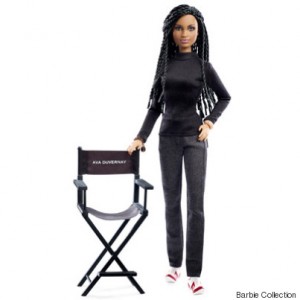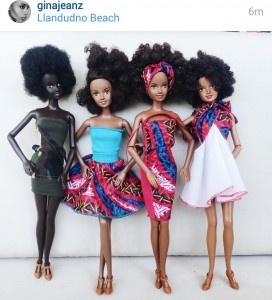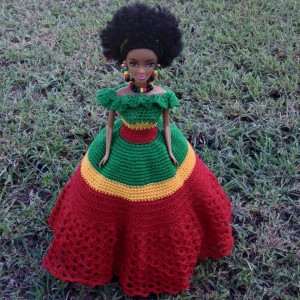
Of Christmas Gifts, Black Dolls and Stereotypes
December 28th, 2015
Christmas Day has come and gone, and all those gifts have been unwrapped (or ripped open), admired, and enjoyed. Or, in some cases, returned to the store from whence they came. What did you give the children in your life, I wonder?
I ask this question because there has been a discussion in social media (and in the Gleaner) in the last day or two about black dolls. Apparently there were none on the shelves in local toy stores – which is quite ridiculous. There are actually quite a few black dolls out there; some are depictions of well-known black women like Michelle Obama. The Oscar-nominated director of “Selma” Ava DuVernay had a doll out for Christmas. Craft shops in Jamaica have been selling locally made black Jamaican dolls for years – in traditional dress, school uniform etc – but apparently mainstream Jamaican stores don’t want them. Now, the latest locally made Jamaican doll is out – very pretty, with a tiny waist and anorexic arms and a plastic body (which I doubt is locally made). It’s a sort of beauty pageant doll. The discussion on social media mainly centered around the need for black girls to have images and portrayals that reflect their own skin color (but it’s unlikely that all black girls have the same Barbie-style body – so, for me, self-esteem would remain an issue).

Ava DuVernay’s doll sold out on Mattel’s website within minutes, before Christmas. It is, by the way, officially a Barbie doll. Are all dolls nowadays versions of Barbie dolls? Do we want our girls to be versions of Barbies?
Going back to my childhood though (which is way back) – dolls had simply no appeal for me. I spent much of my formative years either A) daydreaming B) reading or C) eating. This explains a lot about my current self, probably. My sister, on the other hand, had a whole army of dolls of all shapes and sizes. She regularly issued formal invitations to her (endless) dolls’ tea parties, which I had to accept (as we shared a bedroom together, I had little choice). But I was scornful of my sister’s dolls. She had one “token male” doll (called Jonathan, I believe) and – surprisingly for the early sixties – one black doll. She was a large, robust doll made of that hard plastic, with chubby cheeks and no hair. My sister knitted a canary yellow jumpsuit for her. I think her name was Boko, and I think she still exists, at my sister’s house; I must ask her. We believed she was African, hence the vaguely African name. She may be a collector’s item, now.
As soon as our younger brother was old enough to be interesting, I laid claim to many of his toys. His toy soldiers battling across the bedspread and his early Lego bricks (rather basic, nevertheless) provided more creative storytelling possibilities for me. I left my sister and her dolls to their own devices.
The other point I wanted to make about the dolls is that I am convinced this is another way to “brainwash” girls into being good little domesticated “mommies” when they grow up. My sister was the perfect example of this (her knitting, sewing and other domestic pursuits continued into adulthood). But my parents allowed me to express myself differently and to surround myself with books, instead of vacantly staring eyes. I couldn’t seem to get my message across to social media friends that, no matter what the color, dolls are a way of conditioning girls.

I saw these multiracial South African dolls on Twitter the other day. Skinny, of course! But attractive.
Even more worryingly – in today’s over-hyped, commercial world of make-believe – these dolls with impossibly long legs, slender waists, long hair and perfect features (à la Barbie) fall into the same category to me as skinny fashion models and tottering beauty queens in bikinis and high heels. They present a “perfect specimen” of womanhood (unattainable for 99 per cent of girls). And what happens when girls cannot reach those insanely high standards? Their self-esteem suffers terribly – just as it does if she does not see dolls or models or beauty queens with her skin color. What’s wrong with me? she asks.
So, it’s all much of the same picture – and, to each his own. Let our children find their own way, though. Peer pressure will creep up on them, and sooner rather than later. The Barbie doll women and the macho men will soon infiltrate their lives. Isn’t it sad?

The same very skinny body type again… This is the newest Jamaican doll, which Gleaner columnist Michael Abrahams wrote about.
Tags: Ava DuVernay, Barbie dolls, beauty pageants, black women, books, children, girls, Michelle Obama, self-esteem, South Africa, stereotypes
The Gleaner reserves the right not to publish comments that may be deemed libelous, derogatory or indecent.
To respond to The Gleaner please use the feedback form.
- We Are the Zoomers
- Living Online with Humans and Birds: NAOC 2020
- Human Trafficking and the Problem of Public Education
- Down Memory Lane
- Are We Ready to Recover from COVID-19?
- Road Safety Matters: Is Your Vehicle Safe?
- Sexual Harassment, Me Too, and the Minister’s Disturbing Giggle
- The Vulnerable Senior Citizens, Private Care Homes and COVID-19
- A Muddle Over Masks
- Here is Something Life-Saving You Can Do: Give Blood!


